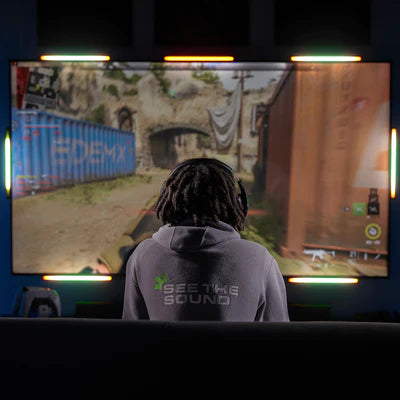With the launch approaching, let’s examine some fantastic engineering and features that make it the tool it is today.
The Exterior
From the knobs to the buttons, every piece was made to provide a modern feel. The sleek black casing aims to complement most gaming setups and is made with high-quality materials to protect the interior components. The aluminum knobs, that control the light bar sensitivity, provide a nice feel when tailoring your experience. For those who like to game in the dark, all the buttons light up for your convenience.
The Interior
Inside the Audio Radar, an advanced motherboard allows for real-time audio processing. This motherboard allows the Radar to read and transmit the audio cues to the lightbars with little to no latency. Using high-performance processors ensures that the Radar can handle high-performing GPUs and does not limit the frame rate. It can support up to 8K at 60Hz, 4K at 120Hz, 2K at 240Hz, and 1080p 240+.
The Light Bars
The light bars are designed to seemingly merge with your monitor or TV for a sleak integration. Every lightbar contains 36 RGBW LEDs capable of producing 16.8 million colors. These high-luminance LEDs enable you to see them night or day.
Connectivity and Integration
The integration of many consoles and systems was crucial to get right. HDMI pass-through functionality allows the Radar to read audio signals without interfering with video or audio quality. The goal was a plug-and-play model that would work with a large range of devices without the need for additional software or drivers. Standard HDMI ensures that a wide range of setups can be implemented in the device. For those of you who use the display port, you can find out how to implement it here:How to Use Display Port with the Audio Radar | Audio Radar Support
Customization
The Audio Radar hosts various customization options, and more are planned for the future. You can adjust sensitivity levels, color schemes, and light bar behaviors. You can also edit individual light bars to fit your exact taste. The Radar also has six presets: three for stream mode and three for action mode. In the future, users can make more presets within an app for easy access.
Updatability and Future Features
The updatabilty of the Audio Radar prevents the need for a new Radar every software update. After the launch of the Audio Radar, updates will be available through an application and the Bluetooth button on the Radar. Future features include functionality for a Minecraft mod that allows the Radar to apply colors for different in-game sounds. We aim to develop an SDK (Software Development Kit) to enable game developers to integrate color applications into their games. For a full dive into future updates, check out this article.




